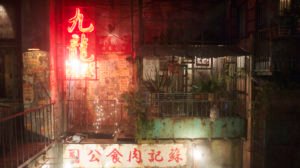
When asked to imagine a post-industrial, urban dystopia, Westerners may summon images from Bladerunner, Neuromancer, Akira, Neo-Tokyo, or Ghost in a Shell. Backdrops of crumbling hyper-density, juxtapositions of poverty and neon, advanced technology and decaying urban infrastructure.
We may imagine humans living like colonies of ants within anarchic, decentralized structures covered in graffiti, filled with crime and the smells of laundry and street food. If asked to point to exact cultural locations, we would think of Tokyo or Hong Kong based upon the films, anime and books mentioned above.
What is it about those cities that brought those qualities to mind, especially as these are already historicized, locked away in 1980’s cyberpunk nostalgia? These cities are now likely cleaner, filled with high rises instead of slums, Still, these images persist due to the powerful work of artists, writers, photographers and filmmakers. Where did it all come from? What were the roots of this post-industrial dystopia and why does it still touch people? What meaning does it all hold for us now in the 21st century…a time of luxury condos and sterile interiors?
Liam Wong, a graphic designer in the video game industry has come to enjoy fame with his photographs of Tokyo on Instagram. Citing influence from Ridley Scott‘s Bladerunner he tells of how he fell in love with Tokyo as his romantically filtered nighttime neon photographs attest.
While looking at his work I reflect on my favorite post-war Japanese photographers who also photographed Tokyo at night, capturing this urban, dreamlike underbelly.
Photographers like Daido Moriyama, or the terribly under-rated Osamu Kanemura whose disjointed, black and white images of post-industrial, post-war Tokyo couldn’t embody the dystopic imagination more. With rare collections with names like Shockhammer or Spider’s Strategy, they capture the darker, industrial aesthetic that is so different than works on Paris for example.
Tokyo emerged from devastation after the war and built itself up in a hyper-modernizing pace as an amalgamation of both industry and pre-modern, Japanese culture. What we in the west see as an exotic juxtaposition actually carries deeper resonance for those in Asia.
This brings us to another city, navigating between modernization and cultural retention: Kowloon City in Hong Kong. Japanese photographer Ryuji Miyamoto captured this infamous locale in his works from 1987. Renowned for his photographs of demolished buildings he carried his expertise at capturing in black and white the detailed layering and texture of industrial decay. Kowloon City, as seen in this footage or Japanese explorers is really interesting as the creative team highlights attitudes urban Japanese have toward space, density and collections that differ from those in the West who might focus primarily on blight, neglect, and code violations.
A longer documentary explains the history of Kowloon City, as one rooted in Chinese resistance to British rule, of creating a self-sufficient city of sorts, albeit one lacking in first world amenities. However, Kowloon City holds powerfully nostalgic value for many 20th century East Asians, as their worlds underwent changes from Colonialism and growing Capitalism. It was an incubator in many ways, a place of liminal transitions, a blurring of post-war ‘village’ with the dark underbelly of industrial urbanism.
When Hong Kong gained its independence and became prosperous, Kowloon City became a blemish from its past, and the government soon set upon demolishing it over a period of many years. Prior to its erasure many architectural and design students from Japan as well as New York rushed to document what they could of this unique walled city. Its impact upon the modern imagination persisted, soon providing a backdrop from everything from kung fu crime movies to science fiction and video games.
The anime artist Mamoru Oshii cites it as the basis for his imaginative backdrop in Ghost in a Shell. The Japanese were so intrigued by Kowloon City that they created a three-story theme park in Tokyo replicating everything they could to preserve its cultural and architectural trace. The documentary footage linked here contains interviews with former residents, historians, artists and designers, all testifying to impact that city had upon post-colonial consciousness and memory.


